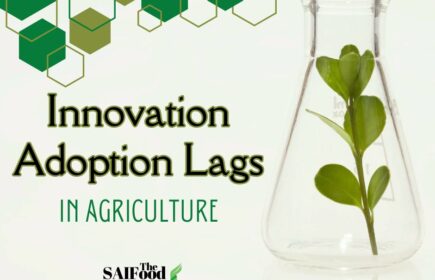Every innovative product of technology that is commercialized eventually reaches what is known as “full adoption”. This is the point at which the peak percentage of society has adopted an innovation. Some innovations reach the point of full adoption more rapidly than others or have higher full adoption rates. The adoption rate of seatbelts in automobiles is far higher than the adoption rate of flex-fuel automobiles.
An American study (2023) on innovation adoption in agriculture found that lags between commercialization and peak adoption are longer than for other innovations, with the average lag period being just over 20 years in the USA. This lag period is longer in agriculture than it is in other economic sectors such as appliances, electronics, and communications. While the decision of an individual to adopt, or not adopt, the use of an energy-efficient washing clothes dryer, computer or cell phone, has no impact on food production, delays in the adoption of agricultural innovations can have large impacts.
Some innovations in agriculture have been rapidly adopted, as the adoption of genetically modified canola, corn and cotton reached peak adoption within a decade of commercialization. Others, such as the use of soil testing or nutrient placement strategies, remain only partially adopted despite lengthy availability. Greater adoption of these technologies can contribute to increased yields. Higher yields result in increased trade volumes and higher gross domestic product and contribute to reducing food prices.
Ag Lag
The question that is commonly asked is, ‘Why are innovation adoption lags so lengthy in agriculture?’. Various answers have been offered; cost being a big factor, as purchasing a new seeding implement costs farmers hundreds of thousands of dollars compared to a consumer purchasing a new cell phone for a few hundred dollars. While the ability to instantaneously share information is a recent global phenomenon, a decade ago, this was more challenging and in agriculture, information is often based on seeing the evidence for oneself, such as adopting a new crop variety. It’s possible to read about the benefits of adopting a new crop variety, some of which may be marketing hype, or to compare independent trial yield results, it is often that before adopting new varieties, farmers want to be able to walk into a crop and speak with the farmer already growing the innovative variety.
Scale also matters as an innovation may show a low adoption rate in agriculture when farms are nationally considered. Smaller farms in many parts of southern British Columbia, Ontario, Quebec, and the Maritimes mean that the adoption of equipment designed for the large, rolling fields of the Prairies, isn’t feasible.
There is no one, single reason why innovations are not more rapidly adopted in the agricultural industry, but rather a combination of the above suggestions, along with numerous others. Given that some innovations have been more rapidly adopted than others, gaining a better understanding and insight into what drives rapid adoption is important. Additionally, improved knowledge concerning what might incentivize more rapid adoption would be important.
Agricultural technical innovations have predominantly been adopted without any financial incentives. These technical innovations have contributed to reduced greenhouse gas emissions, less soil erosion, increased carbon sequestration, and improved moisture conservation. Farmers adopted these innovations as they increased their profitability. Compensating farmers for their beneficial contributions towards climate change mitigation strategies might be one means of gaining more rapid adoption of environmentally beneficial technologies. Incentives are widely used to promote all kinds of technological innovations, such as the tax rebates and subsidies for purchasing electric vehicles. Reducing adoption lags in agriculture has the potential to have broad societal benefits, such as increasing yields, which contribute to reduced food prices. Greater research in this area is required.


